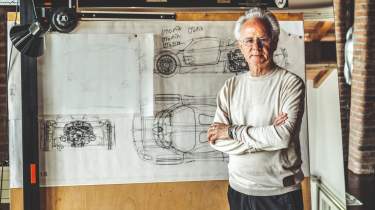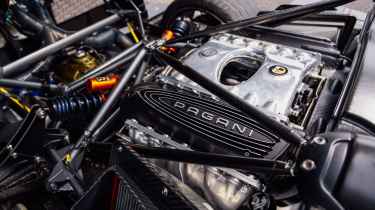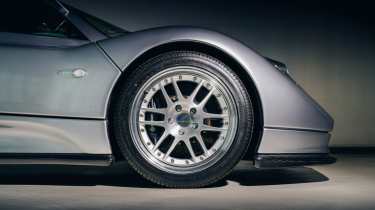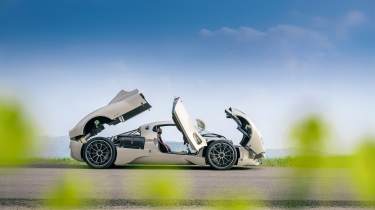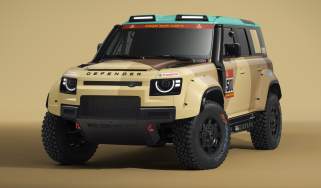Horacio Pagani on the secrets to hypercar success
evo catches up with Horacio Pagani, the man behind the hypercar company we grew up with
Horacio Pagani’s eponymous automobile company is one of the most successful and enduringly enigmatic of Italian supercar marques. While many of the supercar sector’s Big Beasts generate headlines for their financial triumphs or tragedies, Pagani has quietly gone about its business, satisfying a small but ultra-high-net-worth client base with a succession of remarkable multi-million-pound cars.
Pagani rarely talks of production numbers, but according to Horacio ‘around’ 500 cars have been built since 1998, including test and development cars. That’s a tiny number – an average of just 20 per year – but scarcity is central to Pagani’s mystique, as Horacio explains: ‘We produced around 40 cars in 2023. Our target for 2024 was 50 cars. We have been on a growth path since the beginning of our company. There is potential for future organic growth, but we want to ensure that we remain very exclusive, compared to market demand. We are happy with our level in terms of supply and demand dynamics. We don’t need to sell more cars.’
Official Pagani dealerships are now located in the United States, Canada, Germany, the United Kingdom, Switzerland, Denmark, Poland, Saudi Arabia, the United Arab Emirates, Qatar, South Africa, Japan, Hong Kong, Singapore and Australia. Other smaller territories are served by specialist independent dealers close to Pagani, or directly by the factory.
It would be easy to cash in on the growing demand, but when what’s good for Pagani is very good for its customers the result is akin to perpetual motion. This is something Horacio is happy to confirm: ‘The Zonda is currently considered the car that has gained the most value over the last 25 years; up to 23 times its original selling price, according to recent statistics. Some experts consider it the best long-term investment, which explains its high demand, and its appeal beyond traditional car enthusiasts. Harry Metcalfe [evo’s founder] was among the first to anticipate this trend. Too bad he sold his Zonda, as he missed out on an even more substantial retirement fund!’
In a rarefied sector of the automotive industry defined by stock market flotations and complex private funding, Pagani essentially remains a family business, though there are a small number of minority investors. Most notably Saudi Arabia’s Public Investment Fund (PIF), which acquired a 30 per cent stake in 2021.
Horacio remains the patriarch and creative force, but the company long outgrew the man whose name sits above the door, as he confirms: ‘Pagani Automobili is not only about me, it is a team that aims to be the best in the industry. When we started in 1998 there were 14 people across the whole business, but now there are more than 200, aged on average below 32, including artisans, designers and managers. Each of these people individually is among the best in his or her field, but only teamwork can guarantee the result.
‘I have always tried to convey both passion and discipline,’ he continues. ‘Our working method is complicated, because it is inspired by the teachings of Leonardo da Vinci so, for example, each designer must be able to manage the artistic and the technical part at the same time.
> Pagani Huayra Codalunga v Huayra Roadster BC
‘We constantly invest in training and quality in the working environment. In the 1980s I started studying quality systems, first Crosby, then the Toyota System, which is based on the importance of the individual. We introduced this system in 2003, and we integrate it in every new activity. Also, the Dale Carnegie team supports us in every project. And, of course, we continue to enjoy almost 30 years of collaboration with Mercedes-AMG. Our culture is different from that of Japan or Germany, or indeed the US, but this can be an advantage if the creativity and the talent typical of Italians are handled well.’
Both Horacio’s sons – Leonardo and Christopher – hold senior roles in the company, further reinforcing the family ties, and providing a succession plan. In a world where scorn is piled upon ‘nepo babies’, Pagani’s sons have more than earned their place, having spent their whole lives around the company and worked hard to develop skills that benefit the business.
‘They freely chose to work in the company,’ says Horacio, ‘and they are very committed. I think their most important task is to preserve and perpetuate the company’s values and mission, to respect and make our customers happy, and to ensure that the company serves a social purpose and contributes to the growth of the region in which we have always been based.’
Pagani Automobili has a unique relationship with its customers and is focused on the business of giving them what they want, but being inquisitive by nature means Horacio is driven to look beyond his customers’ horizon. Even if it means straying into uncertain and indeed unwelcome territory.
> Driving the Pagani Utopia – car pictures of the week
‘Pagani is the most profitable car company in the world in relation to its turnover, so we are capable of autonomously funding all our own projects,’ he explains. ‘We are naturally curious and have been exploring the realm of electric cars since 2018, even establishing a dedicated team. Undoubtedly, electric powertrains have fantastic features: they generate no direct pollutant emissions during the operations of the vehicle, boast a remarkable power-to-weight ratio and deliver instant torque. However, we must not overlook the numerous drawbacks of the current technology: considering the average mileage of our cars, the ecological balance would still be negative due to the significantly high emissions during the battery production cycle.
‘Our cars have an empty weight of 1300kg. Maintaining an acceptable range for an electric car under two tonnes is a challenge, and this weight can lead to risks at the grip limit, as well as making the vehicle less agile and enjoyable. Moreover, I fear that such weight could shift the driving control more towards electronics than the driver.
‘Additionally, the current battery technology limitations prevent us from developing a super sports car true to our values. It would seem our clients also recognise these limitations, as they have never expressed the desire for an electric Pagani. This absence of demand doesn’t convince us that an electric project is economically sustainable, but it doesn’t imply a lack of belief in technology, simply that the technology is not yet at its peak for adoption.’
Of course, Pagani’s trump card is that thanks to its partnership with Mercedes-AMG, rather than investing its own money in the development of new technologies, it can wait until the tech – and perhaps more crucially, the demand – is proven before committing to an ultra-low volume, ultra-high price tag electric hypercar. As for the present, Pagani Automobili’s immediate focus is on fulfilling customer orders for the Utopia. Deliveries of the 99 coupes are almost complete, with production of the Utopia Roadster well underway. There are also the company’s ‘Arte in Pista’ events, in which customers drive their circuit-only hypercars at exclusive trackdays. According to Horacio these events are proving increasingly popular: ‘We can see customers are really enjoying the experience of driving an extreme car like the Huayra R and definitely see more Pagani track cars in the future.’
> Pagani Zonda F review – revisiting an analogue icon
In addition, there are also the Pagani Rinascimento and Unico programmes, which offer customers the option of a full restoration, or extensive one-off personalisation and customisation service to further evolve earlier Pagani models. At the absolute pinnacle of Pagani’s bespoke operation sits the Grandi Complicazioni division, which undertakes extraordinary clean-sheet commissions such as the Huayra Codalunga.
The thought of modifying a Zonda or Huayra might seem at odds with a market otherwise obsessed with originality, but buying a Pagani has long since become closer to commissioning a piece of art than purchasing an automobile. With so few cars available and a demanding clientele who want things unique to them, providing the opportunity for customers to immerse themselves in the process of modification and personalisation of a pre-owned car to make it their own is very smart. Beyond this, Pagani is expanding into the worlds of property and aviation, with its Pagani Arte offshoot working on commissions for the interiors of apartment buildings in Dubai, and Airbus and Gulfstream in the private jet sector.
‘We have brought all the mechanical processes in-house by investing in technologies, certified the company for the aeronautical field, already created three interiors for large helicopters, and now we are working on interiors for large private jets, focusing on design, composite materials and metal parts. We are developing an innovative furniture line, interior designs for buildings, hotels and residences around the world, with an office in Milan and a highly skilled team. Of course, our core business is in the automotive industry, but the Pagani Arte team is involved in remarkable projects.’
If you count yourself as a petrolhead the future feels uncertain, fearful even. Pagani acknowledges the jeopardy that exists for those who are unwilling or unprepared for what may come, but voices what many of us feel in our bones about the current one-size-fits-all approach to the automotive industry’s part in reaching net zero: ‘It is important that politics support our work seriously, without falling into ideologies, so that all manufacturers can have a future. Otherwise, the risk is that divergent and costly paths will be taken, damaging an industry that has always been a driving force for progress, leaving millions of people unemployed and favouring entities that operate with questionable seriousness.’
A little over 25 years since evo first travelled to San Cesario sul Panaro to drive the original Zonda C12 development car. It is extraordinary and yes, a little emotional, to see how Pagani Automobili has flourished without losing the essence of its appeal.
